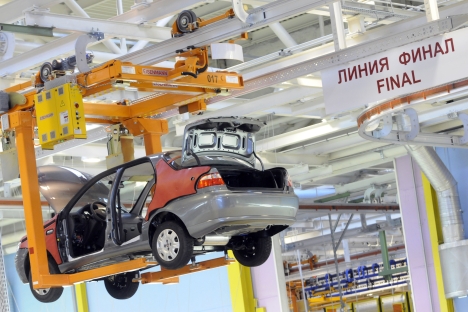Carmakers turn to BRICS for growth

Despite a moderate downturn in car sales seen in Russia from the beginning of the year, the country is a critical automobile market, which is projected to surpass Germany in the future. Source: ITAR-TASS
Despite a moderate downturn in car sales seen in Russia from the beginning of the year, the country is a critical automobile market, which is projected to surpass Germany in the future.
While European car sales continue to
experience a sharp downturn, leading
manufacturers such as U.S. carmaker Ford Motor Company are investing
heavily in emerging markets and pampering customers there with new models.
Ford Sollers, the local joint venture of
Ford, announced on Tuesday that it was going to assemble the EcoSport SUV at
one of its factories in Yelabuga, Tatarstan. Production of the SUV in Russia is
to start in late 2014.
Also announced were plans to build a new
auto engine factory next to the existing car plant in Tatarstan. The facility
is to start operating in 2015 and will make 105,000 engines annually with an
option to increase this capacity to 200,000 units per year. It will allow Ford
Sollers to equip at least 30 percent of vehicles it makes here with locally
produced engines, the company said in a statement.
Ted Cannis, head of Ford Sollers, said in
an interview that the company first introduced the EcoSport in Brazil a little
over a year ago, where it was a big success. Then, a month ago, the vehicle was
brought to China, and in several months it will appear in India. The Russian
launch comes before the start of the production of the SUV in Europe, where car
sales have been declining since 2010.
The prices at which the EcoSport will be
sold in Russia were not announced, with a company spokesman only saying that
they “will be competitive.” In Brazil, the dealers’ prices for this model start
at $26,000. At Ford dealers in Mumbai, India, prices for EcoSports range from
$16,500 to $20,000.
Despite a moderate downturn in car sales
seen in Russia from the beginning of the year, the country is a critical
automobile market, which is projected to surpass Germany in the future.
“Definitely, the rate of growth in the
country is slowing down but the market is still growing. With 3 million [cars
produced annually] — it is a big industry,”
Cannis said. “Despite Europe’s absolute
total problem there is no panic in Russia. If Russia can do this well with its
best trading partner having such a difficult time, what will it be like
afterwards? With our level of operation here it should be a very exciting
future,” he added.
And the market is far from being saturated.
The country still has half the number of cars per person than Spain, Cannis
said.
Ford Sollers, a joint venture with local
auto-assembling giant Sollers, started a year and a half ago and has advanced
from producing just two cars — the Focus and Mondeo — at a plant near St.
Petersburg to seven models, including the Galaxy, S-MAX, Transit, Kuga and
Explorer at the two factories Ford Sollers has in Tatarstan.
As of last month, the large SUV Ford
Explorer is under full-scale production with the Kuga crossover to follow soon,
the management said.
Related:
Russian-made limousines in store for officials
How to turn a used Russian car into a work of art
The Soviet cars that emigrated
Although Ford Sollers did not confirm that
the EcoSport would be manufactured in Russia, the company did not reject that
possibility after a trial period of kit assembly.
While the local mindset that Russian-made
products are inferior to those produced in Europe or the U.S. is an obstacle, Ford
Sollers believes that the company possesses the necessary facilities and staff
to overcome this stereotype.
“Our experience is that great quality can
be built in Russia … We take the same processes we use in Mexico, the US and
Germany to plants here. And they are world-class. The St. Petersburg plant is
one of the best in the entire Ford world. It beats many countries. And that was
the reason for Focus being the best car of the year for the last three years,”
Cannis said.
And Sollers skills have been a valuable
addition to Ford’s own extensive experience.
“The team in Yelabuga is extremely strong. It was one of the reasons we
founded the joint-venture — they already had skillful people,” he said.
There are 1,500 people working at the
Yelabuga plant, Soller said, and there are plans to increase that number to
2,000 by the end of the year. Another 500 workers will be needed for the engine
plant by 2015.
All rights reserved by Rossiyskaya Gazeta.
Subscribe
to our newsletter!
Get the week's best stories straight to your inbox